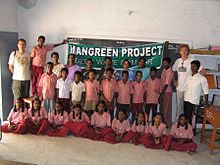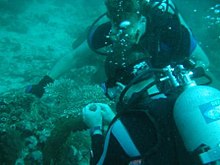Deepwave
Deepwave ( proper spelling : DEEPWAVE ) is a marine protection initiative founded in Hamburg in February 2003 to protect the high and deep seas . The aim of Deepwave is to develop and promote environmentally compatible structures for the marine ecosystem. Deepwave is one of the smaller environmental organizations . Deepwave achieved national and international recognition through the Mangreen and Sailing Against Protein Pirates projects .
Further goals of the marine protection organization are to promote awareness of environmental threats (e.g. through the publication of the marine primer "Our Blue Planet" ), to exert political pressure to eliminate the causes of these threats, to promote the dissemination of scientific knowledge and an organizational one To provide a framework for the exchange of information and opinions on marine issues.
Club data
The founder of the initiative was the marine biologist Onno Groß .
In total, Deepwave has around 70 members from various areas of science, such as B. biology , geodesy , physics , IT and journalism . The members come from countries such as Australia, USA or India and thus control a global network of environmentalists. About 15 activists are active in Hamburg.
Deepwave is financed exclusively through donations. The Lighthouse Foundation , Haspa Lottery, Hamburg's fine fund, members and anonymous donors support the association with a set budget . The most prominent member is the book author Frank Schätzing , who is also on the Advisory Board of Deepwave. For example, Schätzing supports many projects of the marine protection organization through income from benefit readings.
The marine protection organization works with many other well-known environmental protection organizations such as B. DSCC , GSM, DNR , WWF , OMCAR , Greenpeace or IFAW and is a member of a number of other organizations.
The "Mangreen" project
In 2005, Deep Wave and OMCAR have ( Organization of Marine Conservation, Research and Awareness ), a mangrove -Anpflanzungsprojekt in the southern Indian Tamil Nadu named "Mangreen" ( Mang rove Re storation and E cology in I n dia called) to life. UN projects in Asia have shown that these can be successfully replanted. "Mangreen" would like to promote the sustainable growth of the mangrove forests and at the same time improve the ambivalent relationship between the population and their environment with awareness-raising campaigns.
Mangrove seedlings from intact forests are collected for the nurseries . The seedlings are then pulled out by hand and planted in the previously selected intertidal zones. On site, fishermen are instructed in rearing and planting methods as well as observing the seedlings in order to ensure the long-term protection of the mangrove trees.
The reforestation project is coordinated in close consultation with the forest authority in Pattukkottai and marine biologists from Bharathidasan University. The Mangreen project is to run for at least five years in order to provide the coast with new mangrove forests and a sustainable future for the population.
Wallacea expedition
In 2005, the Deepwave and other scientists followed in the footsteps of Alfred Russel Wallace . In 1860 he had discovered and researched the Wallacea region , which was named after him. In order to answer further questions in connection with the emergence of species, historical biography and evolution , the DNA samples taken during diving processes on biodiversity and fauna boundaries are currently being examined using benthic foraminifera (soil animals). The entire project was accompanied by documentary filmmaker Matthias Kopfmüller.
Web links
- Website and Blog of Deepwave
- Sea Primer Blog
- OMCAR - Organization for Marine Conservation, Awareness and Research - English page
- Mangreen - Mangrove Restoration and Ecology in India - English page
- Lighthouse Foundation project description Mangreen
- Tour Wallacea Trailer of the Tour Wallacea

